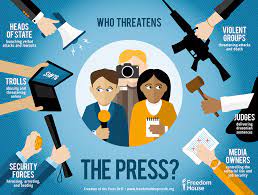Reporters Without Borders’ 2023 World Press Freedom Index reveals increasingly hostile work environments for journalists worldwide on the 30th annual World Press Freedom Day.
The report, which assessed press freedom in 180 countries and territories across the globe, highlights “growing animosity towards journalists” and “increased aggressiveness” from officials in several countries.
According to Christophe Deloire, the organization’s secretary-general, only 3 out of 10 countries have a satisfactory environment for journalism while the environment for journalism is “bad” in 7 out of 10 countries.
The report points out that India, the world’s largest democracy and now most populous nation, has slipped from “problematic” to “very bad,” falling 11 spots to No. 161 due to censorship by Prime Minister Narendra Modi’s government.
The report also highlights that in 2013, Reporters Without Borders identified 26 countries where the state of press freedom was good, however, a decade later, that number has dwindled to just eight, or 4.4% of those evaluated, all of them in Europe.
According to the 2023 World Press Freedom Index by Reporters Without Borders, journalists across the globe face an increasingly hostile work environment.
The report, which assessed press freedom in 180 countries and territories worldwide, found that the state of press freedom is “bad” in seven out of ten countries and only “satisfactory” in three out of ten.
This is largely due to the growing animosity and increased aggressiveness towards journalists from officials in several countries.
In particular, the Middle East and North Africa regions, plagued by growing authoritarianism and repression of protests, present particularly dangerous conditions for journalists.
The situation in Asia and the Pacific is also concerning, as it is home to the two largest jailers of journalists, China and Myanmar.
The Americas have not been spared either, as no country in North, South, or Central America was defined as providing a “good” environment for journalism.
The US, in particular, dropped three places to No. 45 due to the killings of two journalists and widespread violence for reporters and non-reporters alike.
Reporters Without Borders’ 2023 World Press Freedom Index shows that journalists face an increasingly hostile work environment on the 30th annual World Press Freedom Day.
According to the report, the journalistic terrain is characterized by “growing animosity towards journalists” and “increased aggressiveness” from officials in several countries.
The assessment, which surveyed 180 countries and territories globally, found that press freedom is “bad” in seven out of ten countries and only satisfactory in three out of ten.
In particular, the Middle East and North Africa regions present particularly dangerous conditions for journalists, with the state of press freedom dubbed “very serious” in more than half of the countries surveyed.
Asia and the Pacific are home to the two largest jailers of journalists – China (No. 179) and Myanmar (No. 173) – as well as the majority of the bottom 10 countries for press freedom.
Even the Americas have not been spared, as no country in North, South, or Central America was defined as providing a “good” environment for journalism.
The report also highlights artificial intelligence as a foe in the fight against disinformation. However, there are some causes for optimism, with Brazil rising 18 spots to No. 92 and Botswana climbing 35 places to No. 65.
Here are the countries where press freedom is highest, based on indicators such as safety, legal framework, political context, and economic context:
- Norway
- Ireland
- Denmark
- Sweden
- Finland
- The Netherlands
- Lithuania
- Estonia
- Portugal
- Timor-Leste
Here are the countries where press freedom is lowest:
- North Korea
- China
- Vietnam
- Iran
- Turkmenistan
- Syria
- Eritrea
- Myanmar
- Cuba
- Bahrain



